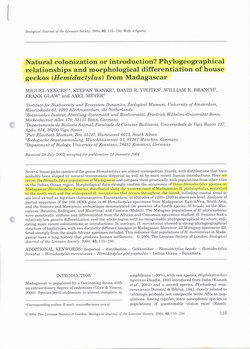|
|
|
|
First Page
 Log In to Edit this page
Log In to Edit this page
|
Natural Colonization or Introduction? Phylogeographical Relationships and Morphological Differentiation of House Geckos (Hemidactylus) from Madagascar
|
Biological Journal of the Linnean Society, 83: pp. 115-130.
|
The Linnean Society of London / Blackwell (2004).
|
|
Stapled Facsimilie
|
Abstract
|
|
Several house gecko species of the genus Hemidactylus are almost cosmopolitan lizards, with distributions that have probably been shaped by natural transoceanic dispersal as well as by more recent human introductions. Here we revise the Hemidactylus populations of Madagascar and compare them genetically with populations from other sites in the Indian Ocean region. Morphological data strongly confirm the occurrence of three Hemidactylus species on Madagascar: Hemidactylus frenatus, distributed along the western coast of Madagascar; H. platycephalus, restricted to the north-west and the widespread H. mercatorius that occurs throughout the island, including coastal areas at sea level as well as big cities (Antananarivo, Fianarantsoa) at altitudes of 1200-1300m above sea level. Analyses of partial sequences of the 16S rRNA gene in 46 Hemidactylus specimens from Madagascar, East Africa, South Asia, and the Comoro and Mascarene archipelagos demonstrated the presence of a fourth species, H. brooki, on the Mascarenes (Réunion, Rodrigues, and Mauritius) and Comoros (Moheli). The Malagasy populations of H. platycephalus were genetically uniform and differentiated from the African and Comoroan specimens studied. H. frenatus had a relatively low genetic differentiation over the whole region with no recognizable phylogeographical structure, indicating more recent colonizations or introductions. In contrast, H. mercatorius showed a strong phylogeographical structure of haplotypes, with two distinctly different lineages in Madagascar. Moreover, all Malagasy specimens differed strongly from the single African specimen included. This indicates that populations of H. mercatorius in Madagascar have a long history that predates human settlement.
|
Keywords
|
|
dispersal, distribution, Gekkonidae, Hemidactylus brooki, Hemidactylus frenatus, Hemidactylus mercatorius, Hemidactylus platycephalus, Indian Ocean, Squamata
|
|
BUY FROM AMAZON.COM
Browse 100s More Titles in our Madagascar Book Store
|
Photographs of the Item (Total: 1)
|
Click image to see larger:
 |
|
|
|
|
| First Page |
|
|
|
|
|
|
© 2006–2025 Daniel Austin
|